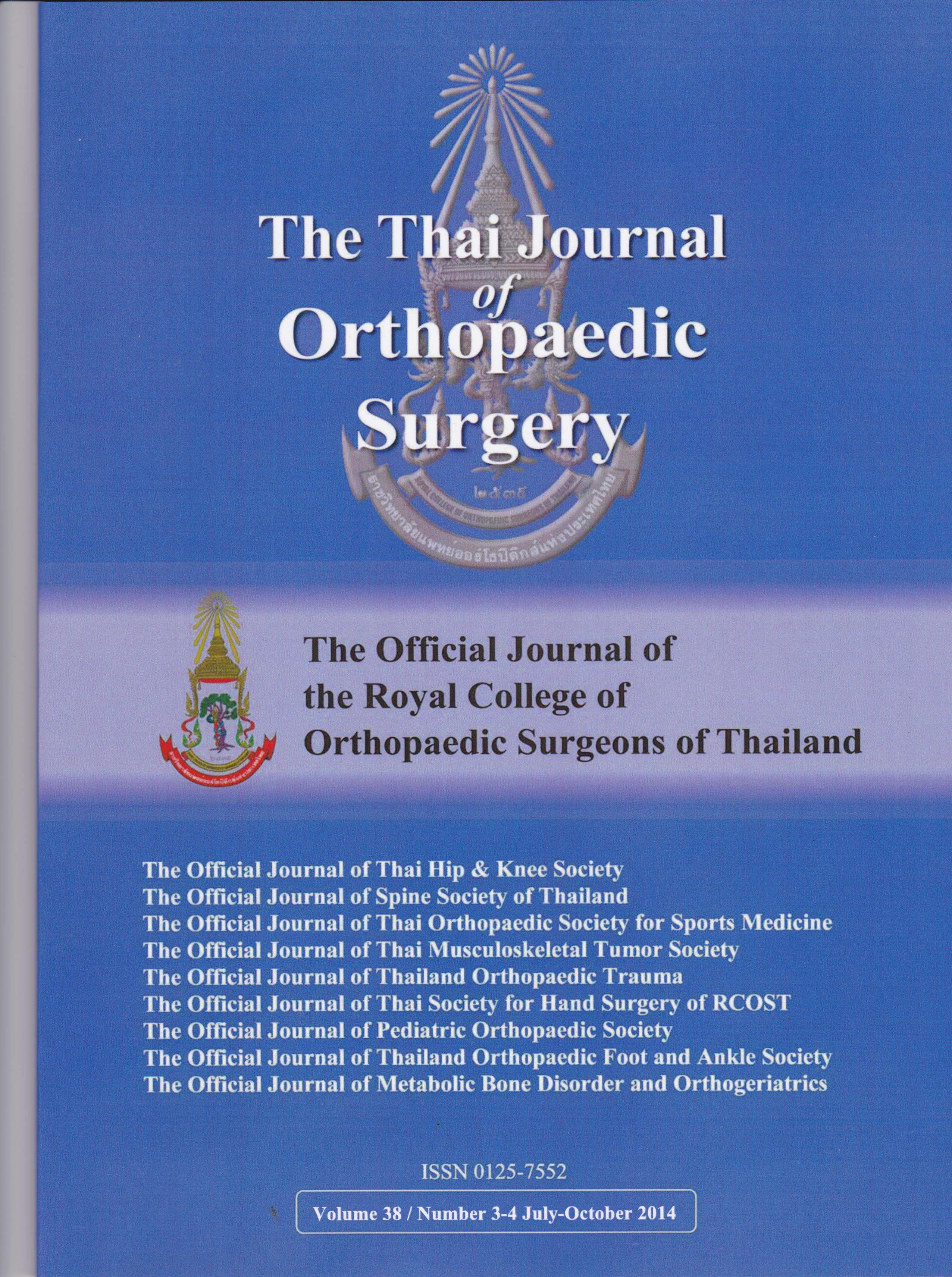Complete Release of Superficial Medial Collateral Ligament in TKA: Surgical technique and mid-term results
Main Article Content
Abstract
Purpose: Intraoperative medial collateral ligament (MCL) injury or attenuation during total knee arthroplasty (TKA) has been reported with satisfactory clinical knee function and stability. However, there was no report on clinical outcomes and knee stability following intentionally complete release of intact superficial MCL (sMCL) during TKA. We demonstrated the surgical technique of sMCL release and reported mid-term clinical outcomes.
Methods: A consecutive series of 35 patients, who underwent TKA and had intraoperatively complete release of sMCL using the subperiosteal technique previously described by Insall, was evaluated for clinical outcomes and knee stability. The surgical technique for sMCL release, the prosthesis and the postoperative rehabilitation protocols were uniform without additional external knee support. A digital dynamometer was used for the quantitative measurement of knee stability in the mediolateral plane at a static 20-lb force. Laxity of the MCL was graded as 0, 1+ and 2+ if the gap was 0 mm, > 0 mm and ≤ 5 mm, and > 5 mm, respectively. Weight-bearing radiographs of patients at the latest follow up (FU) were evaluated.
Results: Preoperatively, the mean tibiofemoral varus angle of the studied group was 14.3° (±6.4°). The mean age and body mass index (BMI) were 70 years, 26.4 kg/m2, respectively. The 10- to 12-mm polyethylene inserts were used in 5% of patients, whilst 14- to 17-mm inserts were used in 95% of patients. At the mean 6-year FU (range: 2-8 years), the mean Knee Society (KS) clinical and function scores were 94.3 and 84.2 points, respectively. The mean maximum range of motion (ROM) was 135.1°. Regarding the knee stability test, knees with grade 0, 1+ and 2+ were found in 84.4%, 15.6% and 0%, respectively. One patient in the studied group had revision due to infection. The 6-year survivorship for reoperation related to MCL instability was 100%.
Conclusion: During ligament balancing for varus knees in TKA, some surgeons tend to avoid performing complete release of the sMCL due to concerns on postoperative knee instability. The subperiosteal release of the sMCL made a full-thickness layer of medial soft tissue attaching with the sMCL, which provided adequate strength to withstand the valgus stress force from daily function. According to the present study, it confirmed a satisfactory mid-term result of TKA with subperiosteally complete release of sMCL in terms of clinical outcomes, knee stability, range of motion, and survivorship. However, it was found that a thicker polyethylene insert related to the release was more common . In conclusion, subperiosteally complete release of the sMCL during TKA provided reliable postoperative medial soft tissue tension and clinical results at mid-term.
Article Details
References
2. Clayton ML, Thompson TR, Mack RP. Correction of alignment deformities during total knee arthroplasties: staged soft-tissue releases. Clin Orthop Relat Res 1986; 202: 117-24.
3. Dixon MC, Parsch D, Brown RR, Scott RD. The correction of severe varus deformity in total knee arthroplasty by tibial component downsizing and resection of uncapped proximal medial bone. J Arthroplasty 2004; 19: 19-22.
4. Mihalko WM, Saleh KJ, Krackow KA, Whiteside LA. Soft-tissue balancing during total knee arthroplasty in the varus knee. J Am Acad Orthop Surg 2009; 17: 766-74.
5. Mullaji A, Sharma A, Marawar S, Kanna R. Quantification of effect of sequential posteromedial release on flexion and extension gaps: a computer-assisted study in cadaveric knees. J Arthroplasty 2009; 24: 795-805.
6. Bellemans J, Vandenneucker H, Van Lauwe J, Victor J. A new surgical technique for medial collateral ligament balancing: multiple needle puncturing. J Arthroplasty 2010; 25: 1151-6.
7. Koo MH, Choi CH. Conservative treatment for the intraoperative detachment of medial collateral ligament from the tibial attachment site during primary total knee arthroplasty. J Arthroplasty 2009; 24: 1249-53.
8. Stephens S, Politi J, Backes J, Czaplicki T. Repair of medial collateral ligament injury during total knee arthoplasty. Orthopedics 2012; 35: e154-9.
9. Nophakhun P, Yindee A, Amornpiyakij P, Hlekmon N, Tanavalee A. The efficiency of the patient care team on 3-day protocol for early ambulation after MIS-TKA. J Med Assoc Thai 2012; 95: 537-43.
10. Yasgur DJ, Scuderi GR, Insall JN. Medial release for fixed-varus deformity. In: Scuderi GR, Tria AJ Jr, eds. Surgical techniques in total knee arthroplasty. New York: Springer-Verlag; 2002: 189-96.
11. Insall JN, Dorr LD, Scott RD, Scott WN. Rationale of the Knee Society clinical rating system. Clin Orthop Relat Res 1989; 248: 13-4.
12. Hood RW, Vanni M, Insall JN. The correction of knee alignment in 225 consecutive total condylar knee replacements. Clin Orthop Relat Res 1981; 160: 94-105.
13. Whiteside LA, Saeki K, Mihalko WM. Functional medical ligament balancing in total knee arthroplasty. Clin Orthop Relat Res 2000; 380: 45-57.
14. Matsumoto T, Muratsu H, Kubo S, Matsushita T, Kurosaka M, Kuroda R. The influence of preoperative deformity on intraoperative soft tissue balance in posterior-stabilized total knee arthroplasty. J Arthroplasty 2011; 26: 1291-8
15. Mullaji AB, Shetty GM, Lingaraju AP, Bhayde S. Which factors increase risk of malalignment of the hip-knee-ankle axis in TKA?. Clin Orthop Relat Res 2013; 471: 134-41.
16. Zhang Y, Hunter DJ, Nevitt MC, Xu L, Niu J, Lui LY, et al. Association of squatting with increased prevalence of radiographic tibiofemoral knee osteoarthritis: the Beijing Osteoarthritis Study. Arthritis Rheum 2004; 50: 1187-92.
17. Ryu J, Saito S, Yamamoto K, Sano S. Factors influencing the postoperative range of motion in total knee arthroplasty. Bull Hosp Jt Dis 1993; 53: 35-40.
18. Selvarajah E, Hooper G. Restoration of the joint line in total knee arthroplasty. J Arthroplasty 2009; 24: 1099-102.


